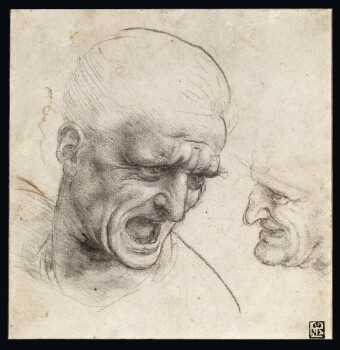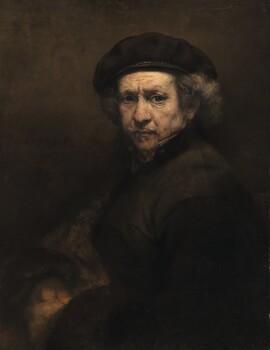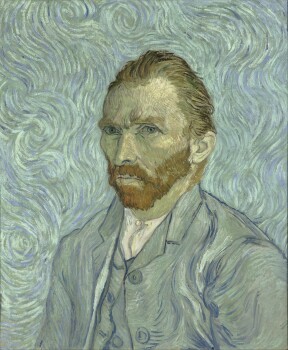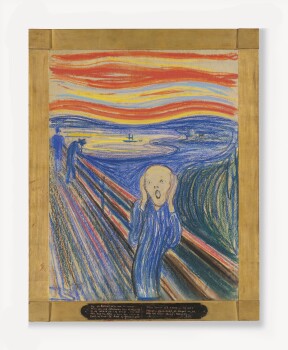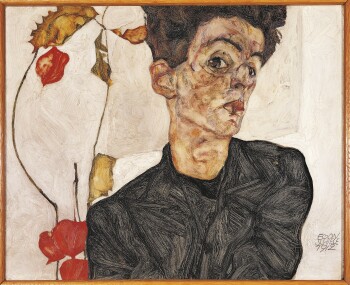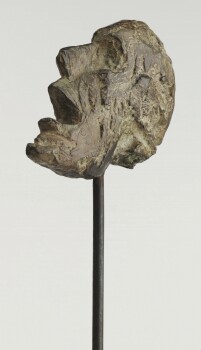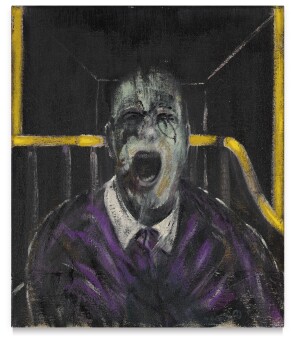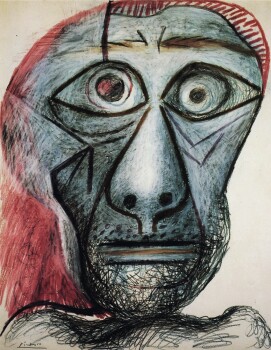
Photo: Beth Phillips. ART © ESTATE OF JEAN-MICHEL BASQUIAT. LICENSED BY ARTESTAR, NEW YORK
O n 29 June in New York, Sotheby’s will offer Jean-Michel Basquiat’s masterwork on paper Untitled (Head), executed in 1982, as a highlight of our Contemporary Art Evening Auction in New York on 29 June 2020.
An explosion of vivid color and frenzied mark-making, the superlative work is a tour de force that stands as one of the most accomplished of Basquiat's ‘Heads’. It is a work from the height of Basquiat’s practice, brimming with barely suppressed fury and energy, tempered by the extraordinary control he exercised in its execution. It reflects the frenetic creativity that characterized New York City in the 1980s, and is an enduring testament to the passionate, emotive and influential spirit of Basquiat’s incomparable and prodigious painterly mark.
Untitled (Head) bears close resemblance to the seminal painting Untitled from 1981 in the collection of The Broad in Los Angeles and, like that work, ranks in the top echelon of the artist's practice. Held in the artist’s collection alongside many of his greatest pieces until his untimely death in 1988, the present work took pride of place in the storied Robert Miller Gallery exhibition of Basquiat’s drawings in 1990 – the show that cemented the works on paper as a cornerstone of his oeuvre.
Untitled (Head) comes to auction with an estimate of $9,000,000 – 12,000,000.

200 BPM: THE JEAN MICHEL BASQUIAT HEAD
JEAN-MICHEL BASQUIAT
1960 - 1988
UNTITLED (HEAD)
oilstick, ink and acrylic on paper
29 ¾ by 22 in. 75.6 by 55.9 cm.
Executed in 1982.
How Jean-Michel Basquiat Turned Art History on Its Head
Explore Basquiat's New York
Jean-Michel Basquiat was born in Brooklyn, but it was in Lower Manhattan that he found his stride as an artist: from his teenage years, when he was one half of the graffiti collaboration, SAMO©, to his mid- to late-20s, when he became synonymous with the Lower East Side art scene. Here, we chart a few of the places that made up Basquiat's New York City – from birth to death.

- Greenwood Cemetery

On 12 August, 1988, Basquiat died from an accidental drug overdose; he was 27 years old. Basquiat was buried at Greenwood Cemetery in Brooklyn. Today, visitors continue to frequent the gravesite, often leaving tributes to the artist: a lighter, a crayon, a tube of paint.
- Park Slope
On 22 December 1960, Jean-Michel Basquiat was born in Brooklyn, NY to Gérard and Matilde Basquiat. During his childhood, Jean-Michel and his family lived in the Park Slope neighborhood of Brooklyn (close to the Brooklyn Museum, of which Jean-Michel maintained a junior membership).
- Washington Square Park
When he was 15, Basquiat ran away from home; for two weeks, he lived in Washington Square Park, nearby to his high school, City-as-School.
Years later, Basquiat sold his graffiti art – including canvases, works on paper, postcards and tee shirts – in the park.
- 57 Great Jones St
57 Great Jones Street was the space where, from 1983-1988, Basquiat lived, created his art and, ultimately, died.

Present-day view of 57 Great Jones St in New York Andy Warhol purchased the space in 1970 and leased it to Basquiat in 1983 for use as a studio and apartment. In August 1988, Basquiat suffered a heroin overdose in the space.
- City-As-School
16 CLARKSON ST
Basquiat attended City-As-School, an alternative high school geared towards artistically-minded students, for a year before dropping out at 17. There he met Al Diaz, a graffitist – the pair become close friends and artistic collaborators, most notably on the early project SAMO©.
Diaz (left) and Basquiat (right) SAMO©, short for "same old shit," began as a comic character, but soon became the pair's calling card; "SAMO©" graffiti tags began popping up throughout SoHo, lower Manhattan and the D train.
- Lower Manhattan
Throughout the mid- and late-1970s, Basquiat and Al Diaz, his friend and collaborator, tagged their calling card – SAMO© – throughout SoHo and other parts of lower Manhattan (along with the D train).

In 1979, Diaz and Basquiat had a falling out, and the collaboration came to an end – infamously, graffiti proclaiming "SAMO© is Dead" began appearing throughout the city.
Following the end of SAMO©, Basquiat began to concentrate on his individual art, and began selling his work – along with tee shirts and postcards – in Washington Square Park.
- Times Square Show
41ST ST AND SEVENTH AVE

THE VENUE OF THE TIMES SQUARE SHOW, 1980. PHOTOGRAPH BY FRANCINE KEERY. COURTESY OF COLAB, INC. Opening on June 1st 1980, The Times Square Show was an exhibition organized by the avant-garde artist collective, Collaborative Projects Inc., in an abandoned massage parlor at the epicenter of New York’s entertainment and pornography district. This show launched the careers of artists such as Keith Haring, Kenny Scharf, Nan Goldin, Jenny Holzer, Kiki Smith – and most significantly, was Jean-Michel Basquiat’s first show as both graffiti artist “SAMO” and a painter.
- Annina Nosei Gallery
100 PRINCE ST

BASQUIAT’S STUDIO, ANNINA NOSEI GALLERY BASEMENT, NEW YORK, 1982. PHOTO COURTESY ANNINA NOSEI GALLERYART © 2017 ARTISTS RIGHTS SOCIETY (ARS), NEW YORK / ADAGP PARIS In 1980, Annina Nosei opened a new gallery location at 100 Prince Street. She was instrumental in launching Basquiat’s career, working closely with him from 1981-1983. Basquiat also used Nosei’s basement as a studio space.
- Mudd Club
77 WHITE STREET

The Mudd Club was a nightclub in the TriBeCa area of New York City, USA, that operated from 1978 to 1983 as a venue for underground music and counterculture events. The Mudd Club was a nightclub in the TriBeCa area of New York City, USA, that operated from 1978 to 1983 as a venue for underground music and counterculture events.
Basquiat frequented The Mudd Club regularly: it's where he played with his band, Gray; where he meets fellow artist Diego Cortez and musicians including Madonna and Blondie; and it's where Basquiat and other East Village artists host numerous exhibitions of their work.
- Mr. Chow
324 E 57TH ST
Since opening its first New York location in 1979, Mr. Chow's has hosted many of the city's top figures in fashion, the arts and music – including Basquiat.
MR. CHOW WITH JEAN-MICHEL BASQUIAT AND BASQUIAT’S MOTHER, MATILDA ANDRADES, AT MR CHOW 57TH STREET IN 1984, IN A PHOTOGRAPH TAKEN BY ANDY WARHOL. COURTSEY THE ANDY WARHOL FOUNDATION FOR VISUAL ARTS/LICENSED BY ARTISTS RIGHTS SOCIETY (ARS) NEW YORK Excerpt from Andy Warhol’s Diary, Wednesday, November 14, 1984:
"Cabbed to Mr. Chow’s for Jean-Michel’s party ($7). And it was great. I feel like I wasted two years running around with Christopher and Peter, just kids who talk about the Baths and things, when here, now, I’m going around with Jean-Michel and we’re getting so much art work done.
Jean-Michel became the hostest with the mostest last night. He said it cost him $12,000— the Cristal was flowing."
- Robert Miller Gallery
524 W 26TH ST
In 1990, several of Basquiat's pivotal works on paper from his own collection – including the present work – were exhibited together in a celebrated posthumous show at the Robert Miller Gallery; the show cemented the reputation of Basquiat’s works on paper as a pivotal part of his oeuvre.
THE PRESENT WORK INSTALLED IN THE EXHIBITION JEAN-MICHEL BASQUIAT DRAWINGS AT THE ROBERT MILLER GALLERY, NEW YORK, NOVEMBER 1990. PHOTOGRAPH: BETH PHILLIPS. ART © ESTATE OF JEAN-MICHEL BASQUIAT. LICENSED BY ARTESTAR, NEW YORK

Enjoy a virtual viewing of the artwork
Basquiat and the Head
Reaching its apex in 1982, Basquiat’s exploration of the human head is his crowning achievement. He realized the universal relatability of this subject, recognizing that his viewers would see themselves in these works, using the intensity of his line, suppressed energy of his composition, and exuberance of his coloration to experience a degree of catharsis.
"What drew Basquiat almost obsessively to the depiction of the human head was his fascination with the face as a passageway from exterior physical presence into the hidden realities of man’s psychological and mental realms…they not only peer out as if seeing, but also invite the viewer to penetrate within."
- 1505
- 1659
- 1889
- 1895
- 1912
- 1947
- 1952
- 1972
- 1981
-
 Leonardo da Vinci, Study of Two Warriors' Heads for the Battle of Anghiari, Museum of Fine Arts, BudapestLeonardo was Jean-Michel Basquiat’s great hero, and it comes as no surprise therefore that it is with the Italian master’s work that the head first became an effective vehicle for psychological charge. Leonardo’s ability to imbue the faces and heads of his subjects with depth and psychological ambiguity, as opposed to the more wooden or caricatured works of his predecessors and contemporaries, is one of the hallmarks of his greatness. Isolated from his body, the head in the present work vacillates between anger, pain and fear, demonstrating the enigmatic qualities that are the hallmark of Leonardo’s work.
Leonardo da Vinci, Study of Two Warriors' Heads for the Battle of Anghiari, Museum of Fine Arts, BudapestLeonardo was Jean-Michel Basquiat’s great hero, and it comes as no surprise therefore that it is with the Italian master’s work that the head first became an effective vehicle for psychological charge. Leonardo’s ability to imbue the faces and heads of his subjects with depth and psychological ambiguity, as opposed to the more wooden or caricatured works of his predecessors and contemporaries, is one of the hallmarks of his greatness. Isolated from his body, the head in the present work vacillates between anger, pain and fear, demonstrating the enigmatic qualities that are the hallmark of Leonardo’s work. -
 Rembrandt, Self Portrait with Beret and Turned up Collar, National Gallery of Art, Washington, D.C.A self portrait from the height of Rembrandt’s practice, this work shows an artist beset by the strains of old age and stresses of life, even at the apex of a formidably successful career. Relentless and unforgiving in his depictions of himself, Rembrandt here uses thick whorls of paint and shocking lead whites to reveal the sagging flesh of his face, gradual reddening of his nose, and resigned sadness of his eyes. Unflinching in its honesty, Rembrandt imbues his composition with remarkable psychological charge and intensity.
Rembrandt, Self Portrait with Beret and Turned up Collar, National Gallery of Art, Washington, D.C.A self portrait from the height of Rembrandt’s practice, this work shows an artist beset by the strains of old age and stresses of life, even at the apex of a formidably successful career. Relentless and unforgiving in his depictions of himself, Rembrandt here uses thick whorls of paint and shocking lead whites to reveal the sagging flesh of his face, gradual reddening of his nose, and resigned sadness of his eyes. Unflinching in its honesty, Rembrandt imbues his composition with remarkable psychological charge and intensity. -
 Vincent Van Gogh, Self Portrait, Musée d’Orsay, ParisA trembling vision of mingled defiance and anxiety, Van Gogh’s late self portrait is defined by the starting intensity of his gaze. Hollow cheeked and emaciated, the artist stares at the viewer, surrounded by a melée of expressive pigment. One of the ultimate self-portraits by an artist forced to the fringe of society, Van Gogh’s painting betrays his isolation as well as his brilliance.
Vincent Van Gogh, Self Portrait, Musée d’Orsay, ParisA trembling vision of mingled defiance and anxiety, Van Gogh’s late self portrait is defined by the starting intensity of his gaze. Hollow cheeked and emaciated, the artist stares at the viewer, surrounded by a melée of expressive pigment. One of the ultimate self-portraits by an artist forced to the fringe of society, Van Gogh’s painting betrays his isolation as well as his brilliance.
Image © National Gallery of Art, Washington D.C. -
 Edvard Munch, The Scream, Private Collection, sold Sotheby’s New York in May 2012 for $119, 922,500One of the most celebrated images in art history, Munch’s The Scream is a painting that has become a visual stand-in for feelings of existential anxiety. Stripped of every civilising feature, sexually-ambiguous, with facial features diminished, it appears dehumanized, spineless and organic, a portrait of pure sentiment and expression.
Edvard Munch, The Scream, Private Collection, sold Sotheby’s New York in May 2012 for $119, 922,500One of the most celebrated images in art history, Munch’s The Scream is a painting that has become a visual stand-in for feelings of existential anxiety. Stripped of every civilising feature, sexually-ambiguous, with facial features diminished, it appears dehumanized, spineless and organic, a portrait of pure sentiment and expression.
Art © 2020 The Munch Museum / The Munch-Ellingsen Group / Artists Rights
Society (ARS), New York -
 www.bridgemanimages.comEgon Schiele, Self Portrait with Chinese Lantern Plant, Leopold Museum, ViennaPulsating with raw, animal intensity, Schiele’s self portrait is both confrontational and fearful. His contorted pose, rendered in Schiele’s idiosyncratic, spiky line, reflects the discomfort of the artist’s position in society. Routinely derided for his libertine lifestyle, and later imprisoned for sexual deviance, Schiele existed on the fringes of society, and his unique style reflected this sense of isolation and abandonment.
www.bridgemanimages.comEgon Schiele, Self Portrait with Chinese Lantern Plant, Leopold Museum, ViennaPulsating with raw, animal intensity, Schiele’s self portrait is both confrontational and fearful. His contorted pose, rendered in Schiele’s idiosyncratic, spiky line, reflects the discomfort of the artist’s position in society. Routinely derided for his libertine lifestyle, and later imprisoned for sexual deviance, Schiele existed on the fringes of society, and his unique style reflected this sense of isolation and abandonment. -
 Alberto Giacometti, Head of a Man on a Rod, Museum of Modern Art, New YorkImpaled in a fashion reminiscent of a Medieval head on a stake, Giacometti’s Head of a Man on a Rod is emotionally confrontational. Its silent scream is compounded by the deep slashes that mark the face, a head weathered by the emotional tribulations of its life. Divorced from the body, this head encapsulates the fear and horror that had gripped Europe for the preceding decade, and the enduring agony of the senseless lost of life that WWII initiated.
Alberto Giacometti, Head of a Man on a Rod, Museum of Modern Art, New YorkImpaled in a fashion reminiscent of a Medieval head on a stake, Giacometti’s Head of a Man on a Rod is emotionally confrontational. Its silent scream is compounded by the deep slashes that mark the face, a head weathered by the emotional tribulations of its life. Divorced from the body, this head encapsulates the fear and horror that had gripped Europe for the preceding decade, and the enduring agony of the senseless lost of life that WWII initiated. -
 Francis Bacon, Study for a Head, 1952. Private Collection, sold Sotheby’s New York in May 2019 for $50,380,000Another of Basquiat’s great heroes, Bacon’s riffs on Velázquez’ portrait of Pope Innocent X from 1650, where he combined the sly gaze of the Spanish master’s portrayal with the iconic scream and shattered pince-nez of a woman in Sergei Eisenstein’s Battleship Potemkin, are among the most celebrated images of the Twentieth Century. Reflecting the anguish of his era, in works such as Study for a Head Bacon locates the mouth as bestial center and agent of the primal scream, lamenting the isolation that he felt within society.
Francis Bacon, Study for a Head, 1952. Private Collection, sold Sotheby’s New York in May 2019 for $50,380,000Another of Basquiat’s great heroes, Bacon’s riffs on Velázquez’ portrait of Pope Innocent X from 1650, where he combined the sly gaze of the Spanish master’s portrayal with the iconic scream and shattered pince-nez of a woman in Sergei Eisenstein’s Battleship Potemkin, are among the most celebrated images of the Twentieth Century. Reflecting the anguish of his era, in works such as Study for a Head Bacon locates the mouth as bestial center and agent of the primal scream, lamenting the isolation that he felt within society.
Art © The Estate of Francis Bacon. All rights reserved. DACS -
 Album / Fine Art ImagesPablo Picasso, Self-Portrait Facing Death, Private CollectionPicasso rendered his own image throughout his career, with every manner of expression, but the extraordinary combination of pathos at his imminent demise and bravery in the face of death distinguishes this work as one of Picasso’s most incisive emotional portrayals. Every line in this work is essential, and the searing honesty and immediacy of the piece is partly due to the honesty of his working on paper. Like Basquiat, Picasso’s innate genius, which spanned all media, was an instinctive understanding of composition, and an ability to render emotion with a few lines that it would take an author thousands of words to convey.
Album / Fine Art ImagesPablo Picasso, Self-Portrait Facing Death, Private CollectionPicasso rendered his own image throughout his career, with every manner of expression, but the extraordinary combination of pathos at his imminent demise and bravery in the face of death distinguishes this work as one of Picasso’s most incisive emotional portrayals. Every line in this work is essential, and the searing honesty and immediacy of the piece is partly due to the honesty of his working on paper. Like Basquiat, Picasso’s innate genius, which spanned all media, was an instinctive understanding of composition, and an ability to render emotion with a few lines that it would take an author thousands of words to convey.
Art © 2020 Estate of Pablo Picasso / Artists Rights Society (ARS), New York -
 COPYRIGHT:JOSHUA WHITE/JWPictureJean-Michel Basquiat, Untitled (Indian Head), 1981The consummate draughtsman of the last half century, with works such as Untitled (Indian Head) Basquiat takes his place among these canonised masters. His depictions of the human head are his most iconic works, possessing an extraordinary emotional charge unrivalled by his contemporaries. Drawing upon the influences of artists such as Leonardo and Francis Bacon, Basquiat developed an entirely unique iconographic lexicon and explosive aesthetic that stands apart from anything that had come before, and indeed anything that has come since.
COPYRIGHT:JOSHUA WHITE/JWPictureJean-Michel Basquiat, Untitled (Indian Head), 1981The consummate draughtsman of the last half century, with works such as Untitled (Indian Head) Basquiat takes his place among these canonised masters. His depictions of the human head are his most iconic works, possessing an extraordinary emotional charge unrivalled by his contemporaries. Drawing upon the influences of artists such as Leonardo and Francis Bacon, Basquiat developed an entirely unique iconographic lexicon and explosive aesthetic that stands apart from anything that had come before, and indeed anything that has come since.













